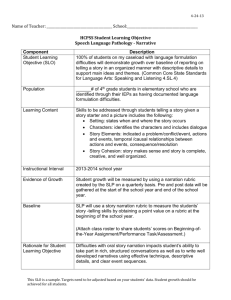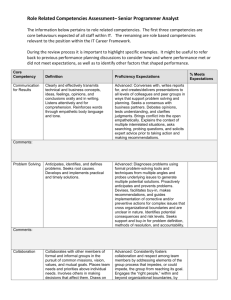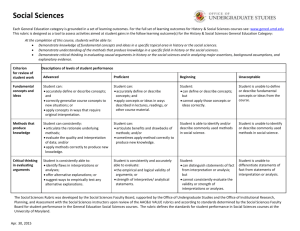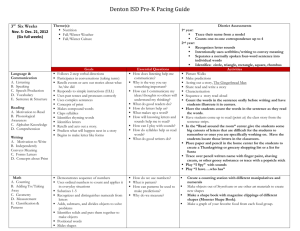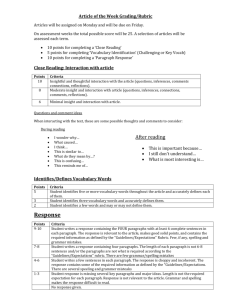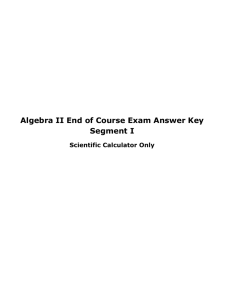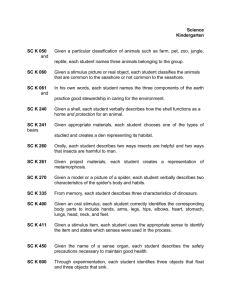Rubrics - ED585Wilkes
advertisement
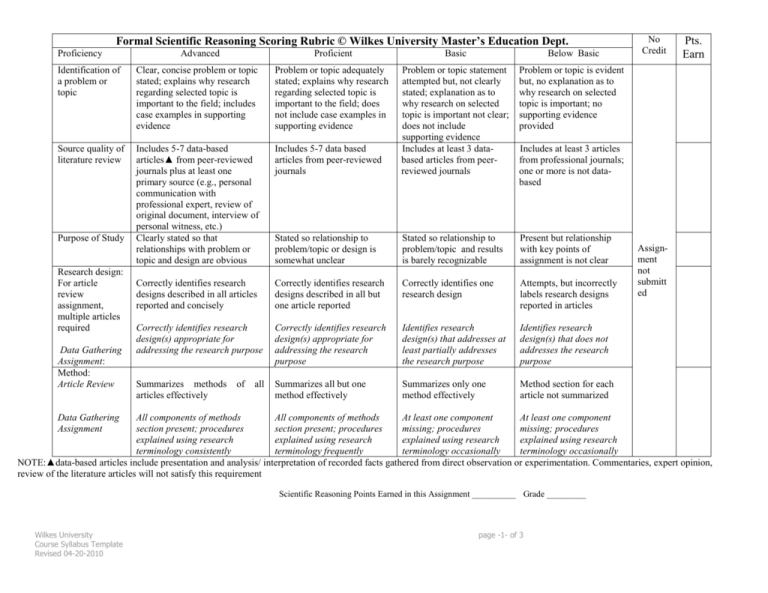
Formal Scientific Reasoning Scoring Rubric © Wilkes University Master’s Education Dept. Proficiency Advanced Proficient Basic Below Basic Problem or topic is evident but, no explanation as to why research on selected topic is important; no supporting evidence provided Identification of a problem or topic Clear, concise problem or topic stated; explains why research regarding selected topic is important to the field; includes case examples in supporting evidence Problem or topic adequately stated; explains why research regarding selected topic is important to the field; does not include case examples in supporting evidence Source quality of literature review Includes 5-7 data-based articles▲ from peer-reviewed journals plus at least one primary source (e.g., personal communication with professional expert, review of original document, interview of personal witness, etc.) Clearly stated so that relationships with problem or topic and design are obvious Includes 5-7 data based articles from peer-reviewed journals Problem or topic statement attempted but, not clearly stated; explanation as to why research on selected topic is important not clear; does not include supporting evidence Includes at least 3 databased articles from peerreviewed journals Stated so relationship to problem/topic or design is somewhat unclear Stated so relationship to problem/topic and results is barely recognizable Present but relationship with key points of assignment is not clear Correctly identifies research designs described in all articles reported and concisely Correctly identifies research designs described in all but one article reported Correctly identifies one research design Attempts, but incorrectly labels research designs reported in articles Correctly identifies research design(s) appropriate for addressing the research purpose Correctly identifies research design(s) appropriate for addressing the research purpose Identifies research design(s) that addresses at least partially addresses the research purpose Identifies research design(s) that does not addresses the research purpose Summarizes methods articles effectively Summarizes all but one method effectively Summarizes only one method effectively Method section for each article not summarized Purpose of Study Research design: For article review assignment, multiple articles required Data Gathering Assignment: Method: Article Review of all No Credit Pts. Earn Includes at least 3 articles from professional journals; one or more is not databased Data Gathering Assignment Assignment not submitt ed All components of methods All components of methods At least one component At least one component section present; procedures section present; procedures missing; procedures missing; procedures explained using research explained using research explained using research explained using research terminology consistently terminology frequently terminology occasionally terminology occasionally NOTE:▲data-based articles include presentation and analysis/ interpretation of recorded facts gathered from direct observation or experimentation. Commentaries, expert opinion, review of the literature articles will not satisfy this requirement Scientific Reasoning Points Earned in this Assignment __________ Grade _________ Wilkes University Course Syllabus Template Revised 04-20-2010 page -1- of 3 Formal Quantitative Reasoning Scoring Rubric for Review of Data-Based Articles, Data Analysis or Data-Gathering Assignments ©Wilkes University, Master’s Education Department Proficiency Level Data Presentation Advanced Proficient Basic Below Basic Data▲ are summarized in a Data▲ are summarized in a Data are visually Data are visually but “well-formed” ◄ manner “well-formed” ◄ manner presented but organization organization of data and visually presented so interpretable with narrative of data unclear; unclear; presentation that it is meaningful ►and explanation; presentation presentation includes more includes more than 3 obvious; presentation has no includes up to 2 errors than 2 -3 errors according errors according to APA errors according to APA according to APA to APA specifications▼ specifications▼ specifications▼ specifications▼ Interpretation Narrative text accurately Narrative text accurately Narrative text accurately Narrative text does not corresponds to data as corresponds to data as corresponds to data as correspond to data; presented; trends correctly presented; thorough analysis presented; few implications of results are identified; implications of of most data; identifies some implications of results are only reiteration of data results (including statistical correct trends attempted, or not fully results significance, if applicable) supported by data are insightful and thorough Confirms or challenges Confirms or challenges with Identifies interpretation of (For review of data-based author(s’) interpretation alternative explanation data provided by Identifies interpretation of articles) with and alternative interpretation of data author(s); provides data provided by interpretation of data provided by author(s); hypothetical example of author(s) provided by author(s); provides example from how information may be provides support for position professionally relevant applied in professional from additional reading in experience work professional literature Application Correctly and appropriately Correctly applies data (e.g., Demonstrates superficial No evidence of linkages explains application of data correct diagnoses and understanding that data among data, data (e.g., correct diagnoses and appraisals) to inform are used to make decisions interpretation, application appraisals) to inform decisions about design of (e.g., make diagnoses or of data to problem solving decisions about design of future action or solve appraisals); or recommendations future action or solve problem(s); makes general recommendations are not problem(s) and makes recommendations logically linked to data specific recommendations for future actions and interpretation for future action ▲Data: recorded facts gathered from direct observation or experimentation ◄Well-formed: data clustered together with correct form, construction, composition or structuring ► Meaningful: data that become useful information when organized for analysis, to reason, or make decisions ▼ See APA Manual for formats addressed by this statement in the rubric (e.g., tables, graphs, etc.) This statement does not apply to visual presentations of data not addressed in the manual. Online instructors, enter comments in comment box: F2F instructors on reverse side of rubric Quantitative Reasoning Points Earned in this Assignment __________ Wilkes University Course Syllabus Template Revised 04-20-2010 page -2- of 3 Grade ___ No Credit Assign-ment not submitted Pts. Earned Wilkes University Course Syllabus Template Revised 04-20-2010 page -3- of 3
